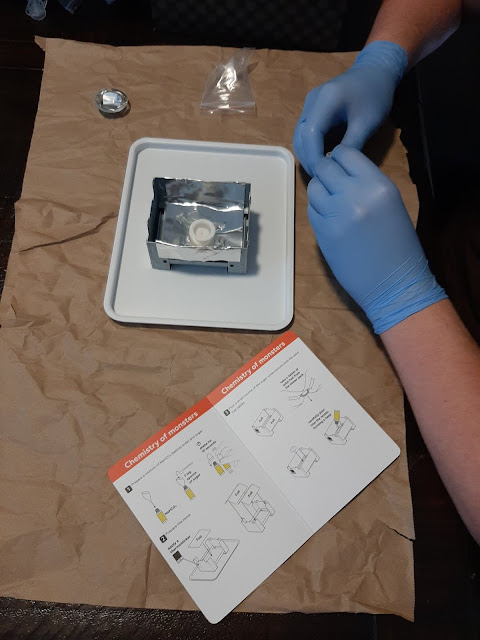We took paints and milk and created marble milk paper in the classroom this week. It was a lot of fun to see the designs that created with each sheet we ran through the milk/paint mixture. It's a simple process of one cup of milk and water colors, food coloring, or paint applied to the milk surface and a plain sheet of paper laid on top. We think the process would have been more uniform with acrylic paints/oil-based paints, but it was still a fun activity with what we used. We allowed the paper to dry in the sunshine.
Thursday, August 27, 2020
Tuesday, May 12, 2020
Chemistry in the Classroom (Chemistry of monsters-Mel Science)
We recently started a subscription to Mel Chemistry and our first science experiment came in the mail this week. It's a chemistry lesson named: "Chemistry of monsters."
For one of the experiments it's a Sugar Snake. We used baking soda and sugar on a heated plate and grew a snake from the two. The chemical reaction with the soda, and sugar, when heat is applied was a good lesson in chemistry, for sure.
This chemistry set came with the following:
- Anthocyanin
- Citric acid x2
- Solid Fuel
- Sodium carbonate x2
- Sodium hydrogen carbonate x2
- Aluminum foil x5
- Double-ended measuring spoon x2
- funnel
- Liquid soap x2
- Protective gloves
- Syringe without needle
- Thermochromic sticker x2
- Wooden stick x4
- Experiment card x2
- Instructions
Sugar Snake: (Grow a black snake out of sugar!)
Foam Eruption: (Foam erupts out of the flask like real lava!)
Wednesday, April 22, 2020
Easter Egg Experiment
We used our leftover Easter eggs to create an egg experiment to see if they could survive a drop from the second floor. We were able to wrap them any anything we wanted, or use cushioning of any kind to keep the eggs from breaking. We wrote down our predictions and then after the experiment we got to see if our predictions and conclusions were the same. We numbered the eggs and each person got a certain number of eggs to try and see how well they held up with their chosen materials during the drops. It was a fun experiment and our Easter eggs went to a good cause-Science!
A lot of them were wrapped in duct tape, tissue paper, electrical tape, twine, cardboard, and some newspaper.
And, then some were given parachutes, or even dropped inside a milk gallon filled with water. It was all about keeping the egg from breaking when it hit the ground. Things were getting tricky and competitive.
A lot of the eggs landed pretty hard on the ground below, but we were surprised at home some of them fell compared to our hypotheses that they would fall in a different way. The parachute egg didn't fall the way we had planned and the parachute never opened, so that egg hit pretty hard on the ground. We just hoped the material it was wrapped in protected it.
The enclosed water egg hit the hardest, but hopes were high that the egg inside was protected by the water that surrounded it.
As we started opening the eggs and seeing which material and egg survived its poor downfall, we were surprised at the ones that hit hard on the ground not bring damaged.
But, some poor eggs didn't survive their plummet.
A few of the eggs were wrapped in plastic jello cups and all of those eggs seemed to have survived the drop. We determined that the plastic cup took the main impact with the ground and therefore protecting the eggs inside.
Remember the water enclosed egg, well it survived the drop, as well. The water actually did help keep it safe. Our hypotheses with some matched up, but with others we were surprised and definitely learned that water can be used as an absorbent.
Subscribe to:
Comments (Atom)







































